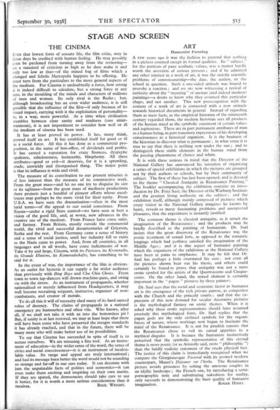ART
Humanist Painting A FEW years ago it was the fashion to pretend that nothing in a picture counted except its formal qualities. Its " subject," for the partisan of pure aesthetic values, was a matter hardly worth the attention of serious persons ; and if he admitted any other interest in a work of art, it was the strictly scientific problems of connoisseurship—the date, the author, or the school in question. Such a one-sided attitude was bound to provoke a reaction ; and we are now witnessing a revival of curiosity about the "meaning" of ancient (and indeed modern) paintings—a desire to know why they assumed this particular shape, and not another. This new preoccupation with the content of a work of art is connected with a new attitude towards historical documents in general. Instead of regarding them as mere facts, as the empirical historian of the nineteenth century regarded them, the modern historian sees all products of the human mind as the symbolic statement of certain values and aspirations. These are in part permanent attributes of man as a human being, in part transitory expressions of his developing consciousness as a historical organism. It is the business of the historian to discover what is permanent ; in what sense it is true to say that there is nothing new under the sun ; and to distinguish these stable elements in the human mind from the passing phenomena of chance and whim.
It is with these notions in mind that the Director of the National Gallery has announced his intention of organising a series of special exhibitions in which the pictures are grouped not by their authors or schools, but by their community of subject. The first of these has just been opened, and is devoted to the theme " Classical Antiquity in Renaissance Painting." The booklet accompanying the exhibition contains an intro- duction by Dr. Fritz Saxl, the Director of the Warburg Institute and the greatest living authority on the subject ; and the exhibition itself, although mainly composed of pictures which every visitor to the National Gallery imagines he knows by heart, reveals so many fascinating problems and unexpected pleasures, that the experiment is instantly justified.
The common theme is classical antiquity, as it struck the imagination of the Renaissance ; and the products may be briefly described as the painting of humanism. Dr. Saxl insists that the great discovery of the Renaissance wits the poetic treatment of sexual love, as opposed to the romantic longings which had perforce satisfied the imagination of the Middle Ages ; and it is this aspect of humanist painting which the organisers of the exhibition at the National Gallery have been at pains to emphasise. It may be felt that Dr. Saxl has perhaps a little overstated his case : not even all the pictures shown bear out his thesis, and others could certainly be found to prove that antiquity was not a mere erotic symbol for the artists of the Quattrocento and Cinque- cento. On the other hand, the sexual element is certainly important in the " pagan " pictures by these painters.
Dr. Saxl says that the social and economic factor in humanist art is the emergence of the rich private patron, as competitor with the Church and the princely courts ; and that the ex- pression of this new demand for secular decorative pictures is the mythological fantasy on erotic themes. When it is asked why these erotic representations should have assumed precisely this mythological form, Dr. Saxl replies that the pagan gods are the only civilised symbols for the organic forces of nature, whose workings now began to fascinate the mind of the Renaissance. It is not for prudish reasons that the Renaissance chose to veil its carnal appetites in a mythical disguise. It is because the humanists instinctively perceived that the symbolic representation of this eternal theme is more poetic (or as Aristotle said, more " philosophic ") than the baldly realistic statement of the crude physical fact. The justice of this claim is immediately recognised when we compare the Giorgionesque Pastoral with its avowed modern counterpart, Manet's Dejeuner sur l'herbe. The Renaissance picture avoids grossness by setting the amorous couples in an idyllic landscape ; the French one, by introducing a semi- pornographic note and substituting nakedness for nudity, only succeeds in demonstrating the finer quality of humanist














































 Previous page
Previous page